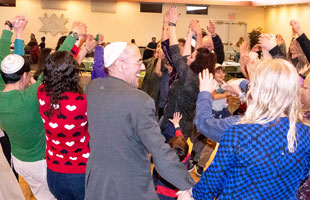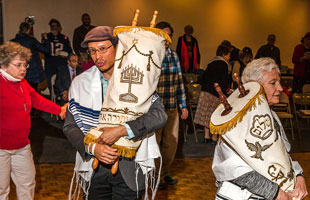The early days of Congregation B’nai Israel are a lasting tribute to the perseverance and unflagging Jewish spirit of its founders. We owe our origins to a handful of enthusiastic men and women who planted the seed of Judaism in the far-flung Southwest. We are bound together much like the straps of Tefillin. Securing our future and enduring with joy for the generations yet to come is our goal.
When Did Jews Actually Arrive in New Mexico?
The Crypto-Diaspora
In the 15th and 16th centuries, Jews from the Iberian Peninsula fled The Holy Office of the Inquisition and sought refuge in the New World.
Their descendants may have converted to Catholicism and become known as “conversos,” Spanish for “the converted.” Some have remained true to their Jewish traditions over the centuries, and secretly practiced their ancestral Jewish faith. These people are now referred to as “crypto-Jews.”
Albuquerque, the high desert city nestled against the Sandia Mountains in central New Mexico, was founded in 1706. As one of America’s oldest cities, it has been inhabited for centuries. It has accumulated a rich history and culture that has included Jews for a very long time. New Mexico’s Jewish-American Heritage is by no means homogeneous. We have come from different places, speak different languages, and practice our faith in many ways, fostered by religious freedom.
1885: Albuquerque's First Mayor
Henry N. Jaffa (1846-1901) moved from Germany to the western United States after the Civil War. He opened a mercantile establishment in Las Vegas, New Mexico and expanded to Albuquerque in 1882. When the city was incorporated in 1885, Jaffa was elected as its first mayor. He helped establish New Mexico’s Congregation Albert (Reform)in 1897.
The First 99 Years of B'nai Israel
The Early Days: 1920-1940s
In 1920, Congregation B’nai Israel was incorporated by a small Jewish community that felt the need for organizing traditional Jewish services, Jewish communal activities, and a Religious School for their children. Among the charter members who worked indefatigably for the success of the congregation, were: D. M. Elias, Hyman Livingston, Ben Marcus, David Meyer, and Aaron Katz, all of blessed memory.
During its early years, without a permanent place to hold religious services, the congregation hovered perilously on the brink of extinction. Services were held sporadically in private homes, hired halls, and when the occasion demanded, even in the rear of stores. The fervent desire to transcend all difficulties kept the spark of life –“the shul”–from being snuffed out.
In 1934, the congregation rented quarters at 116 ½ West Central Avenue and regular services and activities were inaugurated. In 1935, Arthur Ravel assumed the presidency and held the post for seven years. During this period the Jewish community experienced steady growth along with the need for permanent quarters to accommodate the increasing number of worshipers. Plans were made for the construction of a synagogue.
The Ladies Auxiliary, in 1937, purchased a lot at Coal and Cedar Avenues. Enough money was pledged to permit the start of construction on January 15, 1941. On February 9, 1941, the cornerstone–since reinstalled at the entryway of the current building–was laid. The handsome, California-mission style building with whitewashed walls and red tiled roof stood until it was sold, and later demolished, to make way for medical offices in the late 1960’s.
Jack Levick, the first president in the new structure, was elected for a two-year term in 1942. During this time, plans were formulated to purchase land for a congregational cemetery and organize a Chevra Kadisha. David Pincus became the first full-time rabbi of the congregation, and he served until 1942.
In 1944, with Ben Marcus as president, the congregation burned the first mortgage on the building. During the 1940’s administrations of Jack Meyer, Gabe Block, and Jack Mendelsberg, many improvements to the Religious School were made.
Additional land also was purchased for the congregation’s cemetery. The 1940’s Albuquerque community witnessed the arrival of several Holocaust-survivor families. They found a welcoming home within the congregation. Fred Veston, whose memory is still cherished by long-time members, set up a painting studio in the rear of his jewelry shop, at First and Central, where he lovingly recreated cherished scenes of the “Old Country.” Many of his works are on display in the congregation social hall and are part of Congregation B’nai’s Arts & Judaica Collection.
The 1950s
The growth of the congregation mirrored the 1950’s-era expansion of the City of Albuquerque. Jewish scientists, engineers, and enlisted men who were associated with Kirtland Air Force Base and Sandia Laboratories found their spiritual home within the synagogue. They diversified the congregation’s merchant-based membership.
Bernard Leach led the congregation from 1952–1953; David Specter in 1954; Sol Taylor in 1955; Phil Levy from 1956–1957, and Simon Goldman assumed the Presidency in 1958. Old-time members recall synagogue dues being very affordable for all. Periodically, they said, the “balebattim”–the shul’s leaders–would gather to collectively pay off synagogue bills.
During these years a building site was selected for a new, larger synagogue at the location of Indian School Road and Washington Avenue, NE. In 1959, the presidential gavel was passed to Kurt Kubie, who raised $35,000 to purchase this corner, five-acre property. It was also during this period that Philip Pfeffer was engaged to serve as the congregation’s first Cantor.
The 1960s
Lawrence Wayne served as the presiding officer in 1961. In 1962 he was followed by Herman Bloch, under whose leadership the congregation continued to grow and prosper. In 1963, Edward Seliady held office for a year.
Sam Green assumed the Presidency in 1964 for a two-year term. Under his leadership, the remaining indebtedness on the second mortgage was paid, and two additional classrooms were added on the Coal/Cedar site to meet the needs of an ever-growing Hebrew School enrollment.
Phil Levy was re-elected in 1966. In 1967, the Board of Trustees launched a fundraising campaign, chaired by Julius Wollen, to build a new facility on the recently acquired land. Construction seemed assured until the shul, responsive to Israel’s plight in the Six Day War, contributed most of its substantial building fund to aid in Israel’s defense.
When Sidney Gasser assumed the Presidency in 1968, the building fund-drive was resumed. With the cooperation of many faithful and devoted workers, it was successfully concluded. Bids were let, and the ground-breaking ceremonies for the present synagogue, school, and social hall took place in December, 1969.
The 1970s - And Our New Building
The old building held its last service in November, 1970. Shortly thereafter, a traditional Torah procession was made from the old building to the new one with a distinctively designed sanctuary that resembled a golden-yellow “tent,” reminiscent of Biblical gatherings.
The new sanctuary made many recall the traditional Friday evening prayer, Ma Tovu: “How goodly are your dwellings, O Jacob, Your sanctuaries, O’ Israel.”
During Sheldon Bromberg’s administration in 1970, arrangements were made for the sale of the shul’s former home at Coal and Cedar.
In the congregation’s fiftieth year, Irving Friedman was elected President. The congregation obtained the services of Rabbi Isaac H. Celnik in 1971, and with his leadership, attendance at services grew. The congregation was propelled over the next twenty-eight years by his charismatic presence as both ritual leader and teacher
Robert Katz was president in 1973–1974, which coincided with the Yom Kippur War. The congregation, feeling again that Israel was at risk of annihilation, held rallies and raised funds to help support it in every way.
In 1975–1977, during the presidency of Alan Greenfeld, the synagogue was remodeled and a handicapped-accessible ramp was installed.
Marilyn Reinman became president following the untimely passing of Larry Schwartz, holding office from 1978 – 1980. Marilyn, daughter of long-time President Arthur Ravel, was one of the first women chosen to lead a Conservative congregation in the United States.
The 1980s The 1980’s were years of tremendous growth for Congregation B’nai Israel. It was during this period, under the presidency of Brian Ivener, that a pre-school was opened. Enrollment at the Religious School skyrocketed and classes averaged as many as twenty students.
During the next presidencies of Charles Glass (1981–1983) and William DeBois, the congregation continued to enjoy steady growth and balanced budgets.
Under the administration of Wayne Bobrick many still-memorable events were initiated, including beloved Shabbat Dinners held four times a year.
When Howard Friedman followed as president, the Endowment Fund was inaugurated. Under his presidency a major renovation to the building was undertaken: the social hall was enlarged, two new kitchens (one for meat, one for dairy) were installed, and the education wing was expanded. Construction was completed during Burrell Ross’s time in office (1989–1990), which is also when Josh Perlman was hired as Cantor. During the next eight years, Cantor Perlman served as hazzan and he instructed the Confirmation Class students.
The 1990s
The congregation continued to grow while under the leadership of Al Berlin (1991–1993) and Judy Gardenswartz (1993–1995). They focused their efforts on attracting young families to the shul. The Board fully supported the founding of a Solomon Schechter Day School, which called the shul its home until it moved to the new Jewish Community Center facility.
During the second half of the decade of the 90’s, when Madeline Dunn, Bonnie Ivener, David Berlin, and Martin Sherman were congregational presidents, plans were drawn up and funds were raised to remodel the sanctuary. Congregants from those years remember the remodeling-fund drives, the closing-down of the sanctuary when new carpeting, seating, lighting, and sound systems were installed.
When Lawrence Golden became president, the new bimah was installed with the impressive Yehi Or (“Let there be Light”) sculpted letters on the cherrywood doors, which became the place of honor for the congregation’s six Torah scrolls. These sculpted letters were created lovingly by the talent of our longtime member, Harvey Buchalter.
Rabbi Arthur Flicker became the congregation’s new Rabbi, replacing Rabbi Isaac Celnik.
2000-2022
Harvey Buchalter became President in 2003, at which time a gala celebration was held to commemorate the first 85 years of the shul. Caitlin Bromberg, one of the first female Hazzans to graduate from the Jewish Theological Seminary, became Cantor.
Under the presidencies of Alan Chodorow and Keith Harvie, the Men’s Club and Sisterhood grew their memberships, and their innovative programs became national models for other synagogues.
Wayne Bobrick assumed the shul presidency for his second time in 2009. He led the congregation with approximately 280 members who joined him in looking forward to the shul’s next 90 years. In April, 2011, Harvey Buchalter assumed the Presidency of the Congregation, for his “second time around.”
In 2013, William Hochheiser and Robert Lewis became the congregation’s first co-presidents. Following the team leadership, Richard Hammer was elected as president in 2015. Shortly after that, our congregation began a search for a new spiritual leader with the impending retirement of Rabbi Flicker.
In October of 2016, Rabbi Evelyn Baz, our first female rabbi, was installed as mara d’atara. Although her tenure was short-lived, she was a catalyst for our members to undergo a period of rediscovery of who we were as a congregation. Co-presidents, Wayne Bobrick (for his hat-trick) and Elynn Finston, led us through a member-wide survey that helped us to redefine our needs and desires as a Kehilla. Not surprisingly, our members revealed that remaining a Conservative house of worship was the utmost priority, and we gathered strength in learning how important our building, and our members, are to each other.
In April, 2018 Elynn assumed the role as sole president, and oversaw a thorough, well-organized, national search for an Interim Rabbi. Meanwhile, a group of architecture students at the University of New Mexico were conducting research on our congregation’s history and learning about the unusual design of our magnificent sanctuary. Their efforts culminated in a nomination to the New Mexico Cultural Properties Review Committee in Santa Fe, which unanimously accepted nomination of Congregation B’nai Israel for a listing in the National Register of Historic Places.
In 2019, our synagogue’s sanctuary was recognized by the State of New Mexico as being an icon of diversity, and noteworthy architectural design worth historical preservation: our building was placed on the NM Historic Register. See the section below for more details.
With the results of our member snapshot survey having touched all areas of our synagogue life, lay leadership created a weathervane of priorities. This aided a well-organized, thorough national search for an Interim Rabbi. The search came to an end when we found a compatible match to become our Interim Rabbi, Dov Gartenberg, who led our congregation for two years.
In October 2022, following the end of Rabbi Gartenberg's interim tenure, and after an equally thorough national search, Cantor Jonathan Angress became our congregation's spiritual leader.



Become a part of our amazing community
Featured events
Celebrating Congregants with May Birthdays and Anniversaries
Kabbalat Shabbat services will begin at 6 pm on Friday, May 30, followed by a festive Oneg Shabbat. During services, those celebrating special occasions will be called to the bimah to…
Celebrate Shavuot with Food, Music, and Community – First-Ever Shavuot BBQ!
Sunday, June 2nd at 6:00 PM | Congregation B’nai Israel Social Hall (or outdoors, weather permitting) Join us for a joyful evening as we kick off Shavuot with our first-ever…
Ice Cream Social -Dairy Kitchen
All are welcomed for an hour of Ice Cream, cookies, and comradery. Sisterhood invites you to their yearly Ice Cream Social! Let us know you are attending below.
Celebrating Congregants with June Birthdays and Anniversaries
Kabbalat Shabbat services will begin at 6 pm on Friday, June 27, followed by a festive Oneg Shabbat. During services, those celebrating special occasions will be called to the bimah to…




